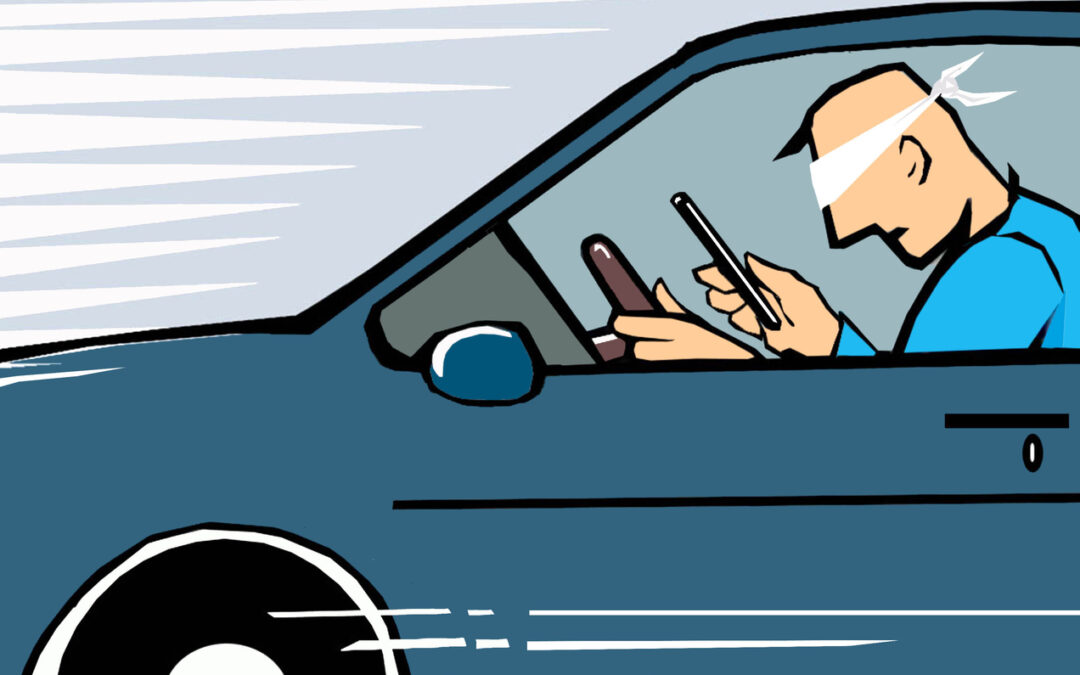How losing sight of your responsibilities on the road can cause long-term premium problems.
Distracted driving is the number-one contributing factor to motor vehicle crashes in New York. And getting ticketed for this offense can be a black mark on your auto coverage rates for years to come. While driving under the influence has become less of a problem in recent years, 2019 ended with an 86% spike in auto accidents caused by cell phone use.
New Yorkers must remember that using a handheld device while driving is illegal under state law, and commercial vehicle drivers must take extra care. Even holding a mobile device while stationary in traffic constitutes use. Only contacting 911 or emergency services like fire and medical is deemed acceptable.
While cell phone use is the leading culprit, distracted driving takes several other forms. Speaking to passengers, drowsiness, using in-car technology, or even eating and drinking all qualify. Where cell phones are concerned, New Yorkers face distracted driving fines ranging from $50 to $200 for a first offense, $50 to $250 for a second offense in 18 months, and $50 to $450 for subsequent offenses in the same period.
Add possible surcharges of $93 and 5 points on your license, and it’s definitely something to avoid. The penalties don’t stop there, however. It’s then the insurer’s turn to enter the picture and make sure distracted drivers keep on paying.
Distracted driving and your auto rates
Ann Carrns of The New York Times highlighted research that reveals how high (and how far) rate hikes can go. Distracted drivers may be facing a double-digit increase that can be locked in place for as long as three years. “Double digits” is fairly vague, but drivers can be sure it’s a figure that insurers will set as high as possible.
This increase in rates is a trend that will likely continue. Insurers are taking more steps to keep an eye out for distracted drivers and catch them in the act. Companies like Zendrive are analyzing billions of road miles to report on the behind-the-wheel cell phone usage of millions of Americans. TrueMotion tracks distracted driving for major providers like Progressive, MetLife, and Nationwide.
The consensus is that more significant amounts of data on individual driving habits will have a three-fold effect. First, data is actionable. The more people are faced with hard facts over conjecture, the more they’ll self-analyze and correct destructive behaviors. Second, people tend to behave better when they know they’re being watched.
Last, it all (potentially) contributes to lower auto rates. One in five insurers are now offering discounts if drivers allow themselves to be monitored. Savings may happen, but many feel that data mining is a step too far and adds loss of privacy as another “cost” of distracted driving.
Distracted driving is making an already costly arrangement more expensive
Distracted driving impacts every driver on the road when it comes to personal safety and the cost of premiums. Even if a motorist never touches their phone while driving, the collective effect of the millions who do causes auto insurers to move premiums up to compensate for the resulting accident claims.
Distractions and accidents aside, New Yorkers are paying a lot for their insurance. Nationally, an average car insurance policy currently costs about $937 a year. Here in NY, that jumps to $1,323 for minimum coverage and $2,752 for full coverage. This puts us in the tenth spot for the highest premiums in the country. Fines, fees, surcharges, and vehicle repairs further hit a distracted driver’s wallet.
NY state does provide an opportunity for offenders to reduce the number of points added to their license for distracted driving. The DMV offers an approved course called the Point and Insurance Reduction Program (PIRP) to help drivers with 11 or more points on their license.
While the points and any tickets given are not physically removed from the license, participation in the course allows drivers to reduce their auto insurance base rate by 10% annually for the following three years. The class isn’t free (yet another distracted-driving expense), but at least it does offer a way to mitigate the effects of the three-year rate hike that insurers may impose.
Use common sense and state-provided safe zones
There’s one inexpensive solution for New Yorkers hoping to avoid these rate increases: ignoring their cell phones while on the road. If you’re experiencing an emergency that requires a rapid response, pull over and make or return any calls or texts. NY state has 90 designated safe zones for drivers to use their cell phones located along the state thruway and highways.
Pausing a few minutes of our individual lives creates collective responsibility, saving everyone money and tragedy in the long run. In the meantime, the NICRIS team can find you the most effective and affordable auto rates to suit your needs. Get in touch to see how we can help.
NICRIS Insurance focuses on providing clients with the appropriate suite of products to protect them, their interests, and their loved ones. If you need some insurance advice or would like a free, personalized insurance review, just drop us a line

